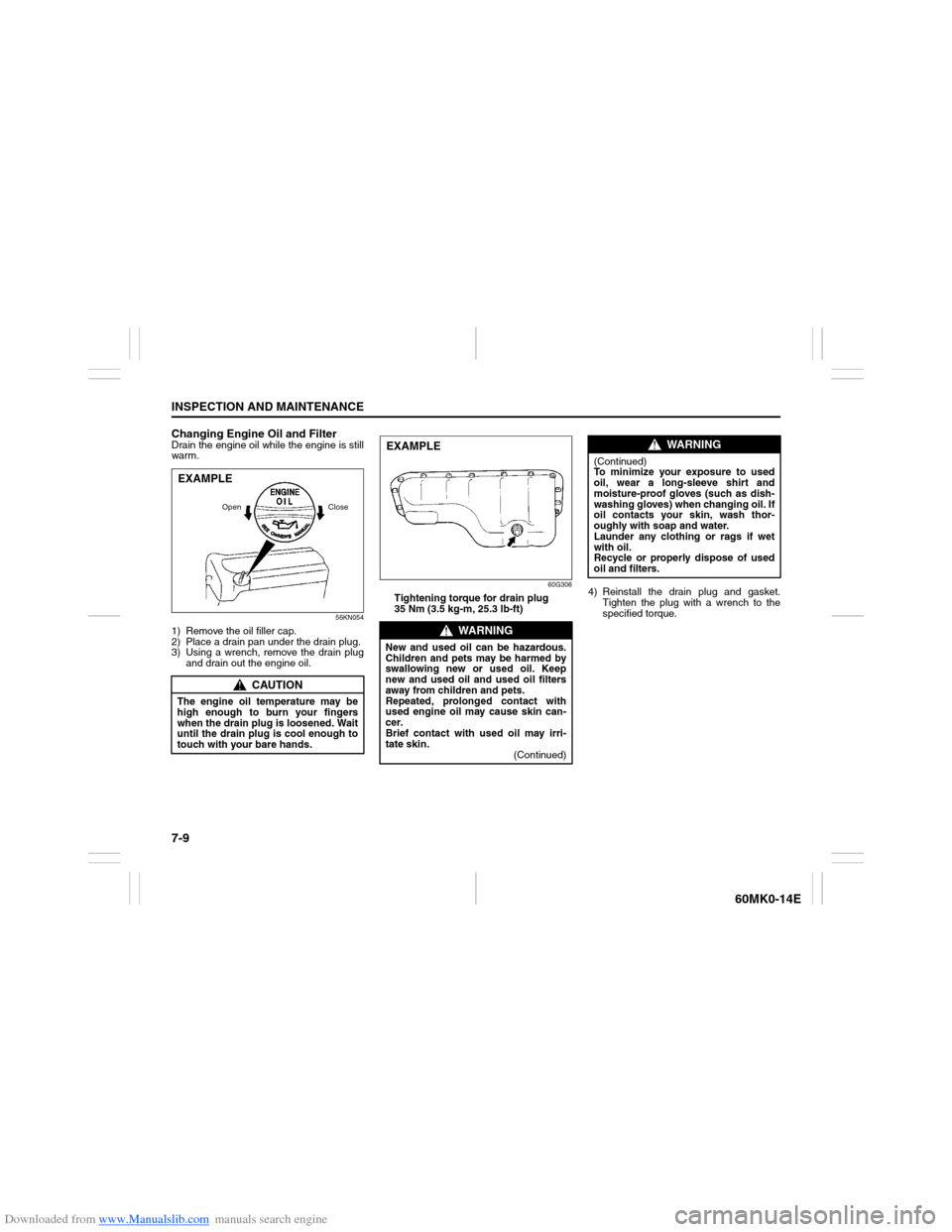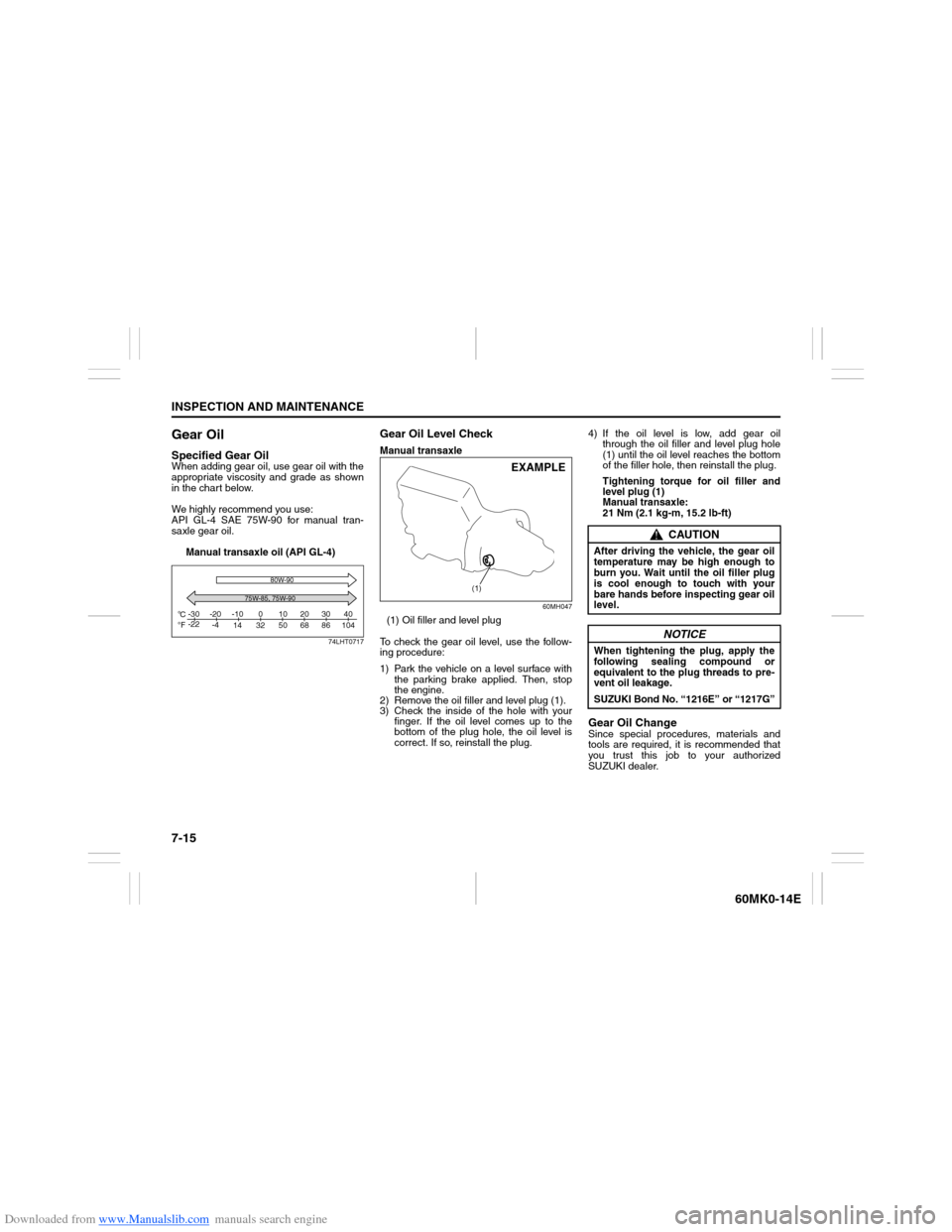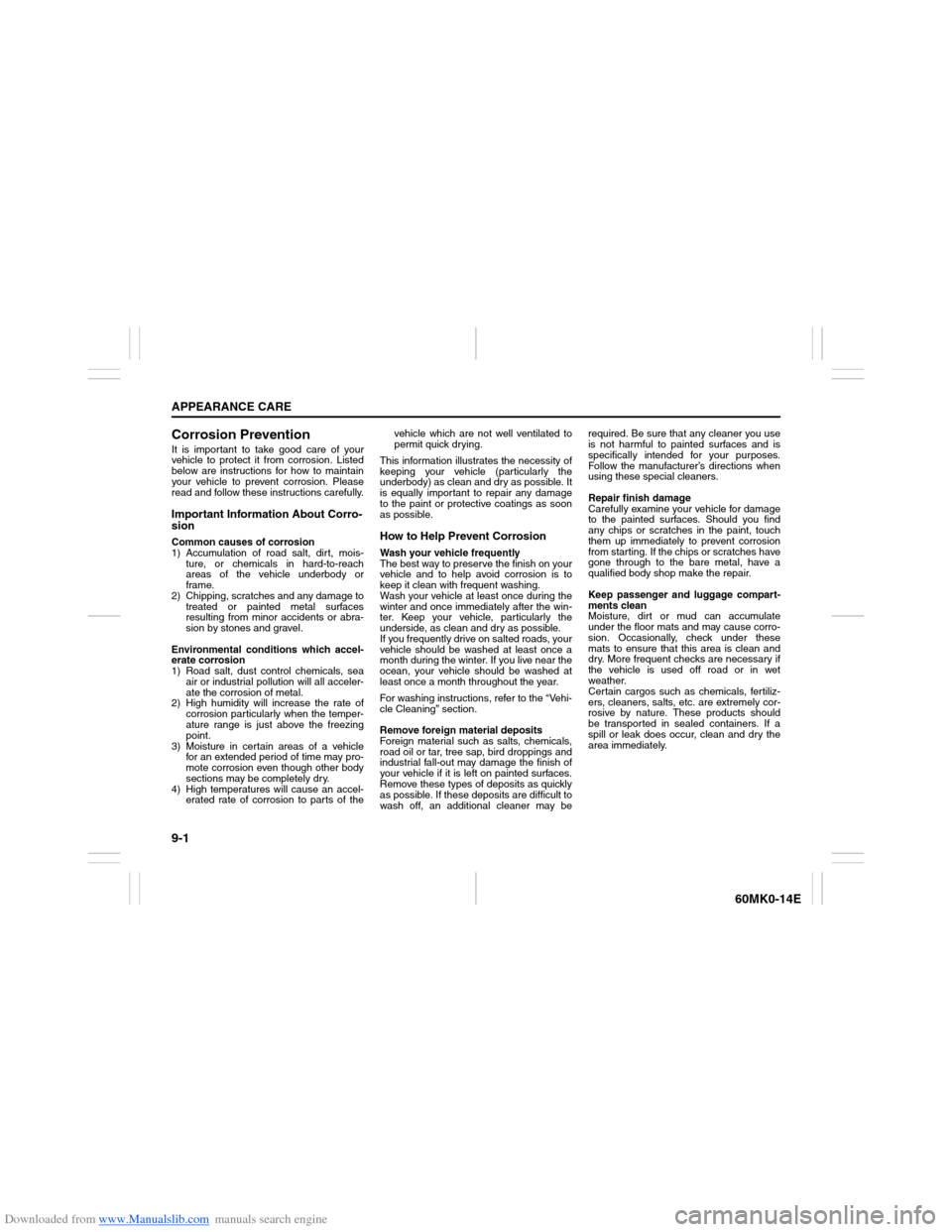2013 SUZUKI ERTIGA oil temperature
[x] Cancel search: oil temperaturePage 100 of 207

Downloaded from www.Manualslib.com manuals search engine 5-5OTHER CONTROLS AND EQUIPMENT
60MK0-14E
blower speed selector to a position other
than “OFF”.
Normal coolingSet the air flow selector to “VENTILATION”,
the temperature selector to the desired
temperature position (other than “OFF”)
and the blower speed selector to the
desired blower speed position. Setting the
blower speed selector to a higher blower
speed position increases cooling efficiency.You can switch the air intake selector to
either “FRESH AIR” or “RECIRCULATED
AIR” as you desire. Choosing “RECIRCU-
LATED AIR” increases cooling efficiency.
Quick cooling (using recirculated air)
The control settings are the same as for
normal cooling except you select “RECIR-
CULATED AIR” and the highest blower
speed.
NOTE:
If you select “RECIRCULATED AIR” for
an extended period of time, the air in the
vehicle can become contaminated.
Therefore, you should occasionally
select “FRESH AIR”.
If your vehicle has been left in the sun
with the windows closed, it will cool
faster if you open the windows briefly
while you operate the air conditioning
system with the air intake selector at
“FRESH AIR” and the blower at high
speed.Dehumidifying
Set the air flow selector to a desired air
flow selector position, the temperature
selector to the desired temperature posi-
tion (other than “OFF”) and the blower
speed selector to the desired blower speed
position. Also select
“FRESH AIR
”.
NOTE:
Because the air conditioning system dehu-
midifies the air, turning it on will help keep
the windows clear.
MaintenanceIf you do not use the air conditioning sys-
tem for a long period, such as during win-
ter, it may not give the best performance
when you start using it again. To help
maintain optimum performance and dura-
bility of your air conditioning system, it
needs to be run periodically. Operate the
air conditioning system at least once a
month for one minute with the engine
idling. This circulates the refrigerant and oil
and helps protect the internal components.
If your air conditioning system is equipped
with air filters, clean or replace them as
specified in the “Maintenance Schedule” in
the “INSPECTION AND MAINTENANCE”
section. Have this job done by your
SUZUKI dealer as the lower glove box
must be lowered for this job.NOTE:
Your vehicle uses the air conditioning sys-
tem refrigerant HFC-134a, commonly
called “R-134a”. R-134a replaced R-12
around 1993 for automotive applications.
Other refrigerants are available, including
recycled R-12, but only R-134a should be
used in your vehicle.
NOTICE
Using the wrong refrigerant may
damage your air conditioning sys-
tem. Use R-134a only. Do not mix or
replace the R-134a with other refrig-
erants.
Page 154 of 207

Downloaded from www.Manualslib.com manuals search engine 7-9INSPECTION AND MAINTENANCE
60MK0-14E
Changing Engine Oil and FilterDrain the engine oil while the engine is still
warm.
56KN054
1) Remove the oil filler cap.
2) Place a drain pan under the drain plug.
3) Using a wrench, remove the drain plug
and drain out the engine oil.
60G306
Tightening torque for drain plug
35 Nm (3.5 kg-m, 25.3 lb-ft)4) Reinstall the drain plug and gasket.
Tighten the plug with a wrench to the
specified torque.
CAUTION
The engine oil temperature may be
high enough to burn your fingers
when the drain plug is loosened. Wait
until the drain plug is cool enough to
touch with your bare hands.
Open Close
EXAMPLE
WARNING
New and used oil can be hazardous.
Children and pets may be harmed by
swallowing new or used oil. Keep
new and used oil and used oil filters
away from children and pets.
Repeated, prolonged contact with
used engine oil may cause skin can-
cer.
Brief contact with used oil may irri-
tate skin.
(Continued)EXAMPLE
WARNING
(Continued)
To minimize your exposure to used
oil, wear a long-sleeve shirt and
moisture-proof gloves (such as dish-
washing gloves) when changing oil. If
oil contacts your skin, wash thor-
oughly with soap and water.
Launder any clothing or rags if wet
with oil.
Recycle or properly dispose of used
oil and filters.
Page 160 of 207

Downloaded from www.Manualslib.com manuals search engine 7-15INSPECTION AND MAINTENANCE
60MK0-14E
Gear OilSpecified Gear OilWhen adding gear oil, use gear oil with the
appropriate viscosity and grade as shown
in the chart below.
We highly recommend you use:
API GL-4 SAE 75W-90 for manual tran-
saxle gear oil.
Manual transaxle oil (API GL-4)
74LHT0717
Gear Oil Level CheckManual transaxle
60MH047
(1) Oil filler and level plug
To check the gear oil level, use the follow-
ing procedure:
1) Park the vehicle on a level surface with
the parking brake applied. Then, stop
the engine.
2) Remove the oil filler and level plug (1).
3) Check the inside of the hole with your
finger. If the oil level comes up to the
bottom of the plug hole, the oil level is
correct. If so, reinstall the plug.4) If the oil level is low, add gear oil
through the oil filler and level plug hole
(1) until the oil level reaches the bottom
of the filler hole, then reinstall the plug.
Tightening torque for oil filler and
level plug (1)
Manual transaxle:
21 Nm (2.1 kg-m, 15.2 lb-ft)
Gear Oil ChangeSince special procedures, materials and
tools are required, it is recommended that
you trust this job to your authorized
SUZUKI dealer.
C
Fo o-30
-22-20
-4-10
14 32 50 68 86 104010203040
75W-85, 75W-9080W-90
(1)
EXAMPLE
CAUTION
After driving the vehicle, the gear oil
temperature may be high enough to
burn you. Wait until the oil filler plug
is cool enough to touch with your
bare hands before inspecting gear oil
level.
NOTICE
When tightening the plug, apply the
following sealing compound or
equivalent to the plug threads to pre-
vent oil leakage.
SUZUKI Bond No. “1216E” or “1217G”
Page 190 of 207

Downloaded from www.Manualslib.com manuals search engine 8-9EMERGENCY SERVICE
60MK0-14E
If the Engine OverheatsThe engine could overheat temporarily
under severe driving conditions. If the
engine coolant temperature gauge indi-
cates overheating during driving:
1) Turn off the air conditioner, if equipped.
2) Take the vehicle to a safe place and
park.
3) Let the engine run at the normal idle
speed for a few minutes until the indica-
tor is within the normal, acceptable
temperature range between “H” and
“C”.If the temperature indication does not
come down to within the normal, accept-
able range:
1) Turn off the engine and check that the
water pump belt and pulleys are not
damaged or slipping. If any abnormality
is found, correct it.
2) Check the coolant level in the reservoir.
If it is found to be lower than the “LOW”
line, look for leaks at the radiator, water
pump, and radiator and heater hoses. If
you locate any leaks that may have
caused the overheating, do not run the
engine until these problems have been
corrected.
3) If you do not find a leak, carefully add
coolant to the reservoir and then the
radiator, if necessary. (Refer to “Engine
Coolant” in the “INSPECTION AND
MAINTENANCE” section.)
NOTE:
If your engine overheats and you are
unsure what to do, contact your SUZUKI
dealer.
79J007
WARNING
If you see or hear escaping steam,
stop the vehicle in a safe place and
immediately turn off the engine to let
it cool. Do not open the hood when
steam is present. When the steam
can no longer be seen or heard, open
the hood to see if the coolant is still
boiling. If it is, you must wait until it
stops boiling before you proceed.
WARNING
It is hazardous to remove the radia-
tor cap (or degassing tank cap for a
diesel engine) when the water tem-
perature is high, because scalding
fluid and steam may be blown out
under pressure. The cap should
only be taken off when the coolant
temperature has lowered.
To help prevent personal injury,
keep hands, tools and clothing
away from the engine cooling fan
and air-conditioner fan (if
equipped). These electric fans can
automatically turn on without warn-
ing.
Page 192 of 207

Downloaded from www.Manualslib.com manuals search engine 9-1APPEARANCE CARE
60MK0-14E
Corrosion PreventionIt is important to take good care of your
vehicle to protect it from corrosion. Listed
below are instructions for how to maintain
your vehicle to prevent corrosion. Please
read and follow these instructions carefully.Important Information About Corro-
sionCommon causes of corrosion
1) Accumulation of road salt, dirt, mois-
ture, or chemicals in hard-to-reach
areas of the vehicle underbody or
frame.
2) Chipping, scratches and any damage to
treated or painted metal surfaces
resulting from minor accidents or abra-
sion by stones and gravel.
Environmental conditions which accel-
erate corrosion
1) Road salt, dust control chemicals, sea
air or industrial pollution will all acceler-
ate the corrosion of metal.
2) High humidity will increase the rate of
corrosion particularly when the temper-
ature range is just above the freezing
point.
3) Moisture in certain areas of a vehicle
for an extended period of time may pro-
mote corrosion even though other body
sections may be completely dry.
4) High temperatures will cause an accel-
erated rate of corrosion to parts of thevehicle which are not well ventilated to
permit quick drying.
This information illustrates the necessity of
keeping your vehicle (particularly the
underbody) as clean and dry as possible. It
is equally important to repair any damage
to the paint or protective coatings as soon
as possible.
How to Help Prevent CorrosionWash your vehicle frequently
The best way to preserve the finish on your
vehicle and to help avoid corrosion is to
keep it clean with frequent washing.
Wash your vehicle at least once during the
winter and once immediately after the win-
ter. Keep your vehicle, particularly the
underside, as clean and dry as possible.
If you frequently drive on salted roads, your
vehicle should be washed at least once a
month during the winter. If you live near the
ocean, your vehicle should be washed at
least once a month throughout the year.
For washing instructions, refer to the “Vehi-
cle Cleaning” section.
Remove foreign material deposits
Foreign material such as salts, chemicals,
road oil or tar, tree sap, bird droppings and
industrial fall-out may damage the finish of
your vehicle if it is left on painted surfaces.
Remove these types of deposits as quickly
as possible. If these deposits are difficult to
wash off, an additional cleaner may berequired. Be sure that any cleaner you use
is not harmful to painted surfaces and is
specifically intended for your purposes.
Follow the manufacturer’s directions when
using these special cleaners.
Repair finish damage
Carefully examine your vehicle for damage
to the painted surfaces. Should you find
any chips or scratches in the paint, touch
them up immediately to prevent corrosion
from starting. If the chips or scratches have
gone through to the bare metal, have a
qualified body shop make the repair.
Keep passenger and luggage compart-
ments clean
Moisture, dirt or mud can accumulate
under the floor mats and may cause corro-
sion. Occasionally, check under these
mats to ensure that this area is clean and
dry. More frequent checks are necessary if
the vehicle is used off road or in wet
weather.
Certain cargos such as chemicals, fertiliz-
ers, cleaners, salts, etc. are extremely cor-
rosive by nature. These products should
be transported in sealed containers. If a
spill or leak does occur, clean and dry the
area immediately.
Page 206 of 207

Downloaded from www.Manualslib.com manuals search engine 12-4INDEX
60MK0-14E
Specified Oil ........................................................................... 7-7
Speedometer ........................................................................ 2-43
Starting a Cold and Warm Engine ........................................ 3-8
Starting the Engine ................................................................ 3-8
Steering ................................................................................ 7-19
Sun Visor .............................................................................. 5-39
Supplemental Restraint System (air bags)........................ 2-30TTachometer .......................................................................... 2-43
Tailgate ................................................................................... 2-4
Temperature Gauge ............................................................. 2-44
Theft Deterrent Alarm System .............................................. 2-7
Thermometer ........................................................................ 2-46
Tilt Steering Lock Lever...................................................... 2-55
Tire Chains ............................................................................. 4-4
Tire Changing Tool ................................................................ 8-1
Tire Inspection ..................................................................... 7-20
Tire Rotation......................................................................... 7-21
Tires ...................................................................................... 7-20
To Raise the Vehicle with a Garage Jack ............................ 8-3
Towing .................................................................................... 8-7
Trailer Towing ........................................................................ 6-1
Transaxle selector position indicator
(for automatic transaxle vehicles)...................................... 2-47
Transaxle Warning Light ..................................................... 2-41
Trip meter ............................................................................. 2-48
Turn Signal Control Lever................................................... 2-52
Turn Signal Indicators ......................................................... 2-42
Turn Signal Operation ......................................................... 2-52
UUniversal Serial Bus (USB) Socket..................................... 5-42
USB device ........................................................................... 5-23
Using the Transaxle ............................................................... 3-9VVehicle Cleaning .................................................................... 9-2
Vehicle Identification ........................................................... 10-1
Vehicle Loading...................................................................... 6-1WWalk-in Type Seats (for 2nd row seats) ............................. 2-17
Warning and Indicator Lights ............................................. 2-38
Washing .................................................................................. 9-4
Waxing .................................................................................... 9-5
Windows ............................................................................... 2-11
Windshield Washer .............................................................. 2-54
Windshield Washer Fluid .................................................... 7-35
Windshield Wiper and Washer Lever ................................. 2-53
Windshield Wipers ............................................................... 2-54
Wiper and Washer Operation .............................................. 2-54
Wiper Blades ........................................................................ 7-31